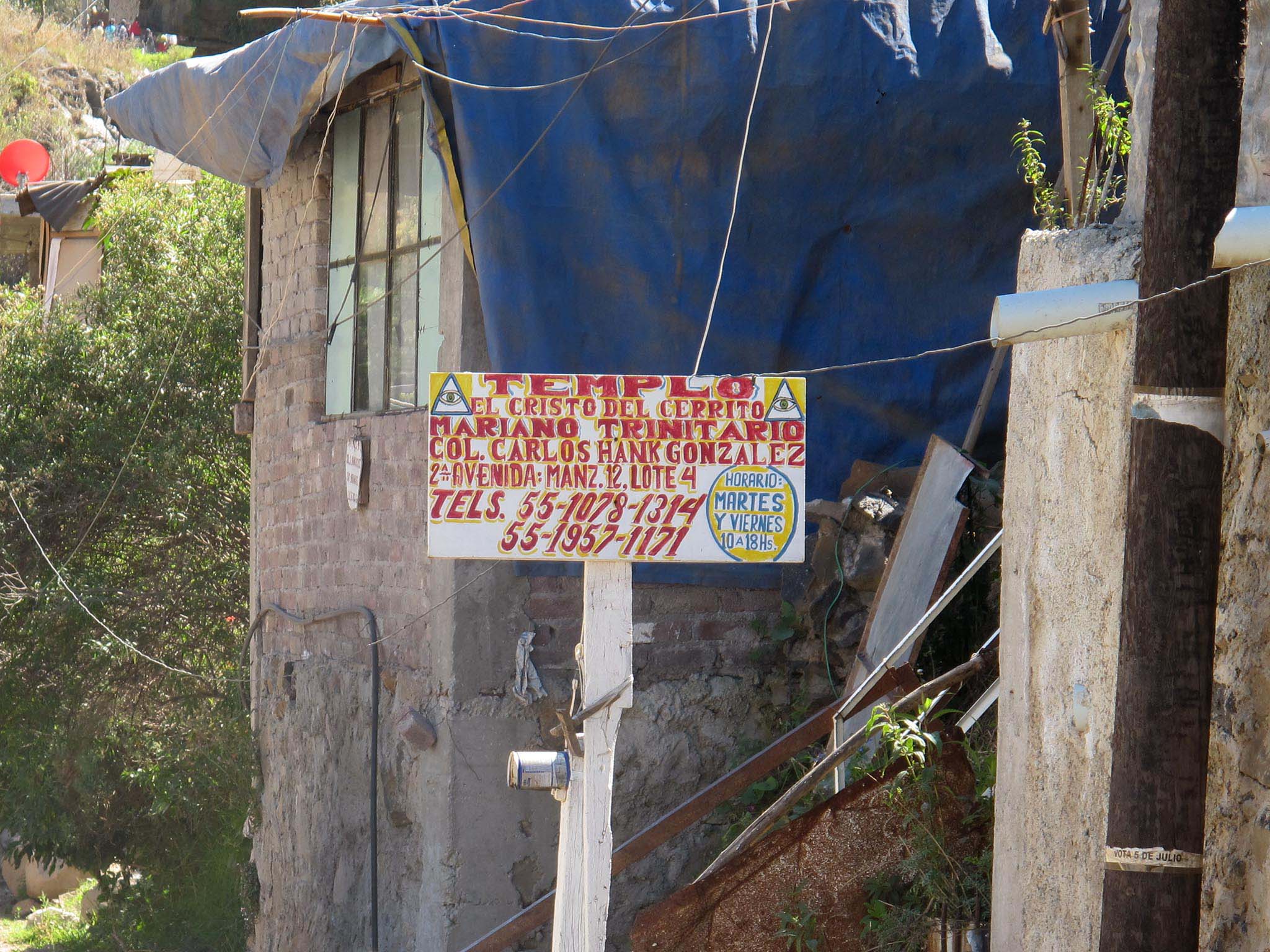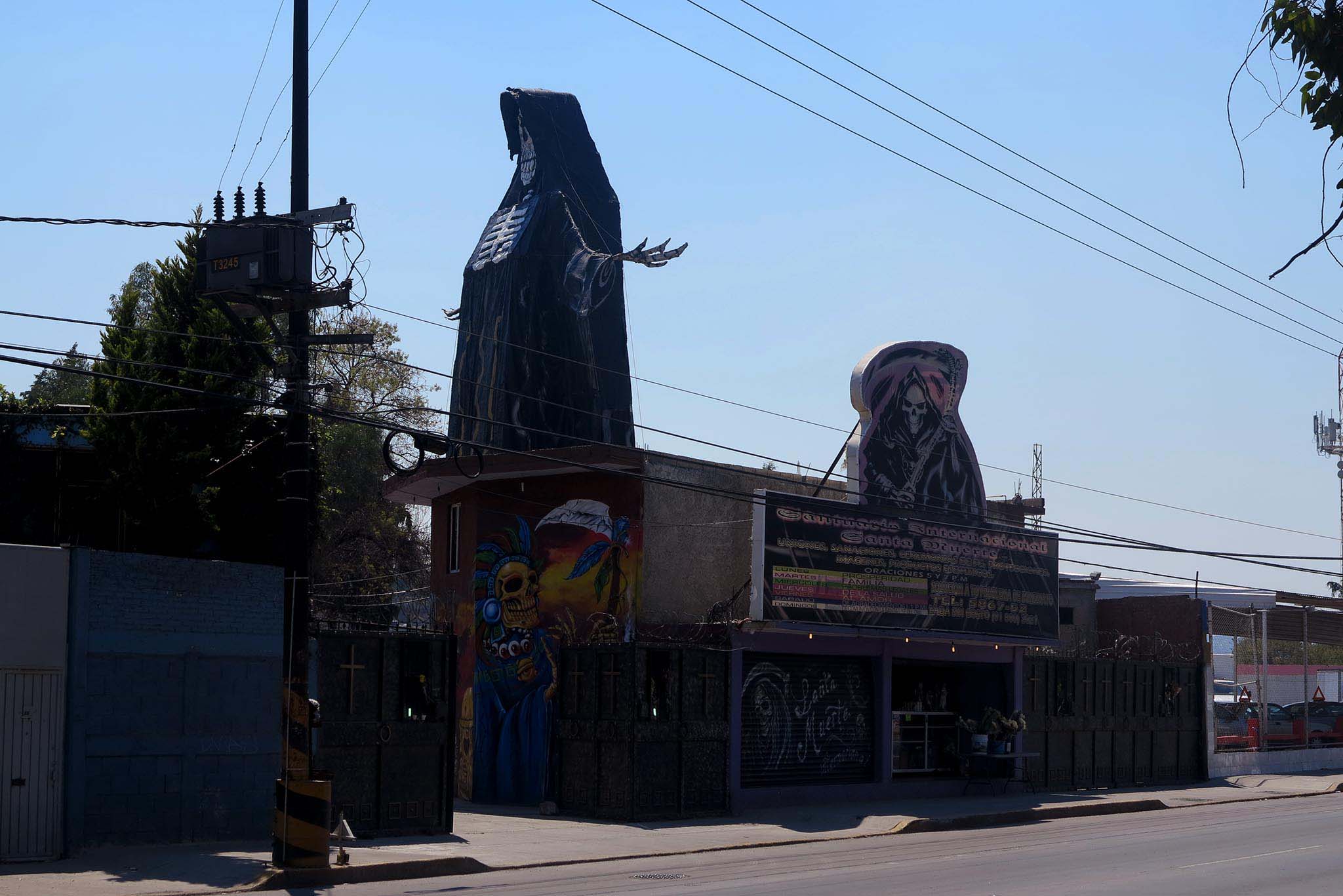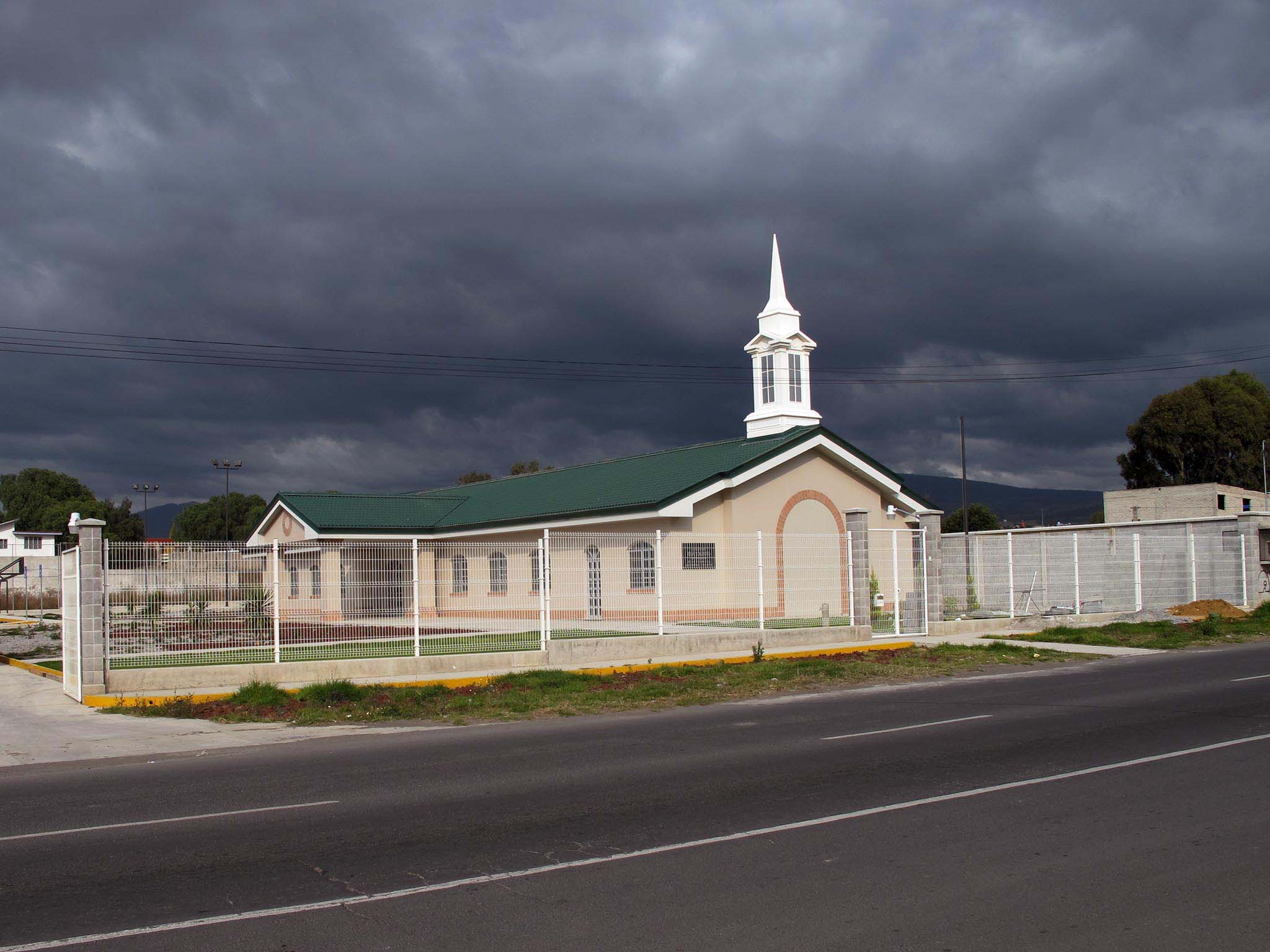Introduction
Mexicans are a deeply spiritual people. Religious images are everywhere, in car parks, gas stations, along roads in grocery stores. Mexico is almost a religious entity instead of a political one, a patchwork of shrines and saints. The edge of mexico City is a place of enormous religious dynamism as people’s beliefs change when confronted by a new environment. Instead of becoming less religious people become differently religious. At the same time Mexican’s are creatively religious, able to invent their own rituals and doctrines. The edge of Mexico City is a cauldron of religious innovation.

Syncretic Catholicism – Milpa Alta

Every year the 3rd of January the people of San Francisco Tecoxpa in Milpa Alta go on a 7-day pilgrimage to Chalma over the mountains 100 kilometers away in the State of Mexico. The trip takes about two days, and images are carried from the parish church to Chalma where they are kept over night in the sanctuary next to the revered image of the Lord of Chalma. They are than carried back, recharged by the yearly trip to the divine figure in Chalma. This walk through the mountains started before the Spanish even came to Mexico.
During the pilgrimage songs are sung in praise of the Lord of Chalma. These slow dirges are completely the opposite of an uplifting cheerful protestant psalm. And when one listens to the lyrics there is a clear recognition in them that the people of Milpa Alta once worshipped demons but have been uplifted to the light by the Lord of Chalma. This explicitly is a song of pre-Hispanic gods being defeated and the acceptance of the people of Milpa Alta into the light by the Christian god.

The pilgrimage is itself a circular event, like the Aztec calendar. After going several years one understand that there is only one pilgrimage and that each reiteration on the third of January simply adds a little bit to it, like the spiral growth of a shell. By going on the pilgrimage you become part of the great story of the one pilgrimage encompassing the village´s history. And those who have participated in the pilgrimage have their place in its memory.
Religious festivities such as the pilgrimage are also the moments for community service. People will give food for free to the pilgrims or pay large sums of money towards the pilgrimage’s organization. Not only is the village saint an important marker of geographical identity, the community structure is also largely defined during religious ceremonies. During these ceremonies many people have different roles, from being a bearer of an image to organizing the pilgrimage in its totality.
Finally images underlie the essence of syncretic Mexican Catholicism. A village that loses the image of its founding saint is unprotected and sure to suffer catastrophe. The founding saint inevitably appeared miraculously so they cannot be replaced by some store-bought statue. It is as if the saint has chosen the village and the statue is the physical manifestation of that choice.
Trinitarios Marianos – Iztapalapa

The Trinitarios are one of the least well-known large Mexican religious groups. One estimate puts the number of worshippers at 6 million people. They are followers of Roque Rojas, who they consider to be the Mexican Messias. Rojas was born in 1803 in Mexico City and died in 1870. During the early 1860s he had a revelation that he was the third Messias after Moses and Jesus Christ. Following this revelation he founded seven churches with their respective leaders, colors and insignia, each church based on one of the seals mentioned in the Apocalypse of St. John. After his death the churches continued.
Roque Rojas claimed descent from Otomi priests and according to the Trinitarios his family were crypto-Jews. The church’s principle symbol is a stepped pyramid with an eye on the apex. This religion has 22 commandments some of the most sympathetic ones are commandments to treat the poor with respect and to visit the sick whenever one can.
In the twenties the leader of the Church of the Sixth Seal Damiana became involved in spiritism, which was fashionable at the time even up to the circles of Mexico’s president Francisco Madero. The Trinitarios Marianos are the spiritual descendants of this combination of spiritism and belief in the Mexican Messias. Spirits, often of indigenous healers, from pre-Hispanic times descend into Trinitarios with the gift and assist in healing rituals. Sometimes God or the Virgin Mary herself will descend into priests.

This religion is primarily popular among the poor. For that reason this faith is common in poor neighborhoods and unknown outside of them. Due to the fact that God himself, Jesus and the Virgin Mary speak at masses there are many divisions in the church as these messages are interpreted differently. So many of these churches have strange names disguising the fact that all these little churches though they in principle adhere to Trinitarian practices. According to Silvia Ortiz Echaníz, a researcher at the National Institute of Anthropology and History, the Trinitarios themselves estimate that they have approximately eight million adherents.
Notable characteristics of this religion are its rejection of the material world and materialism in favor of the spiritual world, its explicit pre-Hispanic ancestry, the use of Mexican traditional medicine and a great dynamism impelled by constant divine revelation which reflects itself in many schisms.
Santa Muerte-Tultitlán

The Santa Muerte is religious current originating in the central neighborhood of Tepito in Mexico City in the 50 and 60s. Tepito has traditionally been Mexico’s largest black market, point of sale of smuggled wares, counterfeit goods and stolen merchandise. In many ways the Santa Muerte reflects its place of origin, materialist and operating in moral limbo with money being a common offering at shrines. Mexico is becoming more like Tepito, a place of organized informality and opportunism, where rules are crossed lightly. And as Mexican culture changes the Santa Muerte rides this change across the country and over its borders. .
Though death seems like a very spiritual event in reality the Santa Muerte seems to celebrate materialism and status, more like a momento mori, a reminder to pluck the day because you will die sometime, glitzy and bit brash. On the other hand death takes all comers sooner or later. Death does not discriminate between rich or poor, male or female, good or bad. Death even forgives the politically incorrect, a perfect divinity for the deregulated market place.
In 2008 Jonathan Legaria Vargas, known as Comandante Pantera erected a temple to the Santa Muerte in Tultitlán. Shortly afterward he was killed by unknown gunmen who shot him more than 50 times according to newspaper reports. The shrine remains in function as a place for masses and rites and a point of sale for charms, statues and books. Rituals for supernatural assistance with practical problems can be commissioned.

The Santa Muerte is a statement about the breakdown of faith in authority and rules, its rapid spread through Mexico maps the breakdown of social values in favor of individualism. Yet despite its very noticeable presence it is weighed down by the very values it promotes.
Crime does pay and the Santa Muerte may help the job get done but creating a religious doctrine and social structures around it are another story completely.
Latter Day Saints

The Church of the Latter Day Saints of Mormons is an ubiquitous presence on the edge of the city. One sees the missionaries, pairs of young men dressed in white shirts and black slacks who dedicate a year to seeking out new converts, walking in the streets, strangely incongruous. Chappels with their distinctive triangular roof and pointed tower are also a common sight, especially in Colonia Cuautepec Barrio Bajo, where the church has various chapels and a boarding school.
The spread of Mormonism in Mexico is no coincidence. It is an aspirational religion, a ticket to the middle classes, as evinced by its neat missionaries with their neckties and nameplates. But the church is also a smooth running urban machine. When about 20 new converts have formed a community the church will rent a house for them where they can pursue their activities. As the community grows the church starts looking for land to buy in the vicinity. Once it has reached about 70 people the land is bought. Afterwards a meeting hall fitting about 100 people is built according to plans coming from Salt Lake City.

There is often a basketball court a great care is taken that the lawn is always green. The clearest indication of the aspirational nature of this religion is that there are three models of buildings calibrated to look somewhat better, but never too much better than their direct environment. This sense of a new normality, not too special but nonetheless different, explains a lot about how aspirational tensions present in many peripheral neighborhoods, as does the north American build and feel of the chapels.
The plot of land is large enough for two halls and as the community grows so do the buildings. Once they have reached their capacity of 200 people the community is divided. A new chapel is built at least half-an-hour away by public transport. And so the church grows like an organic network in the urban fabric.
Santeria

This voodoo religion of Afro-Cuban origin is highly popular in Mexico City, especially among the police, where on sector commander told me that 20% of the federal district police force is santero. Santeros can be recognized by the beaded bicolored bracelets and necklaces, as well as all white-dress on ceremonial occasions. The color of the bracelet indicates to which particular orisha or godhead a person is devoted. The bracelets which seem most common are the green and yellow beads of Orumla, the god of prophecy and the red and white beads of Shango the god of war.
Santeria has a strong magical component and animals are sacrificed in order to obtain supernatural intervention in secular affairs. This practical aspect supposedly is one of the reasons why this cult is popular among the police who continually operate in the morally and ethically complicated grey zone of systemic corruption and public service. In a society as spiritual as Mexico where magical means are a common recourse when in trouble any streak of bad luck pushes people towards magical practices and means of protection. This makes Santeria a good religion for people in precarious situations. It also can make Santeria a good business for babelao’s or priests since a magical ceremony can be a concrete investment in health, happiness or fortune.

Santeros have quite festive communal events with music, food and dance, in private houses and rented events halls. It is not uncommon for percussionists who are not santeros to play at these events. Though they pay is relatively good the percussionists are required to learn particular Afro-Cuban rhythms required to participate in religious call and answer during the ceremonies. Adherents are expected to learn Yoruba, the language of the ancient kingdom of Benin in Nigeria, in order to be able to pronounce ritual invocations and advance in this religion.
Santeria has white and black magic practitioners which also makes it attractive for those who do not want to be constrained by orthodox notions of good and bad. It is also reputedly in vogue among people working in the entertainment industry and in that sense it is a little stylish.
